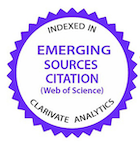Initial growth of forage cactus clones at different potassium fertilization levels
DOI:
https://doi.org/10.1590/1809-6891v22e-70836EAbstract
The objective was to evaluate the effect of different levels of potassium fertilization on the initial growth of forage cactus (Nopalea cochenillifera Salm Dyck) clones. The experiment lasted six months, arranged in a randomized block design, in a 5 x 2 factorial scheme, with five levels of potassium fertilization (0, 250, 500, 750, and 1,000 kg of K2O ha-1) and two forage cactus clones (Little Sweet and Giant Sweet), with four replicates. One cladode was planted per pot (experimental unit) with a capacity of 7 kg of soil (24 x 17 x 23 cm). During the experimental period, the plants' structural characteristics were evaluated, such as plant height and width, length, width, thickness, and perimeter of the cladode, as well as accounting for the number of total cladodes, and in order of appearance. At the end of the experiment, biomass was evaluated to determine the fresh matter (FM) and dry matter (DM) yield of the aerial part and the root system. After determining the DM, the potassium content in the plant tissues was determined. The data were submitted to ANOVA and, if necessary, to the Tukey test at a 5% significance level. The potassium fertilization and the forage palm clones did not exert influences based on the variables evaluated during the experimental conduction. Potassium fertilization does not influence the structural and productive characteristics and the potassium content in the N. cochenillifera clones' initial growth.
Keywords: Nopalea cochenillifera; potassium; semiarid.
Downloads
References
Donato PE, Pires AJ, Donato SL, Bonomo P, Silva JA, Aquino AA. Morfometria e rendimento da palma forrageira ‘Gigante’ sob diferentes espaçamentos e doses de adubação orgânica. Revista Brasileira de Ciências Agrárias. 2014; 9(1), 151-158. DOI:10.5039/agraria.v9i1a3252 DOI: 10.5039/agraria.v9i1a3252
Pinheiro KM, Silva TGFD, Carvalho HFDS, Santos JEO, Morais JEFD, Zolnier S, Santos DCD. Correlações do índice de área do cladódio com características morfogênicas e produtivas da palma forrageira. Pesquisa Agropecuária Brasileira. 2014; 49(12), 939-947.
DOI: 10.1590/S0100-204X2014001200004
Silva TGF, Primo, JTA, Morais JEF, da Silva Diniz WJ, de Souza CAA, Conceição Silva, M. Crescimento e produtividade de clones de palma forrageira no semiárido e relações com variáveis meteorológicas. Revista Caatinga. 2015; 28(2), 10-18.
Oliveira FT, Souto JS, Silva RP, Andrade Filho FC, Júnior, E. B. P. Palma forrageira: adaptação e importância para os ecossistemas áridos e semiáridos. Revista Verde de Agroecologia e Desenvolvimento Sustentável. 2010; 5(4), 27-37.
Silva TGF, Primo J T A, Silva, SMS, Moura, MSBD, Santos DC, Silva MDC, Araújo JEM. Indicadores de eficiência do uso da água e de nutrientes de clones de palma forrageira em condições de sequeiro no Semiárido brasileiro. Bragantia. 2014; 73(2), 184-191.
DOI: 10.1590/brag.2014.017
Queiroz MGD, Silva, TGF, Zolnier S, Silva S, Lima LR, Alves JDO. Características morfofisiológicas e produtividade da palma forrageira em diferentes lâminas de irrigação. Revista Brasileira de Engenharia Agrícola e Ambiental. 2015; 19(10), 931-938.
DOI: 10.1590/1807-1929/agriambi. v19n10p931-938
Lima JJ, Mata JDDV, Pinheiro Neto R, Scapim CA. Influência da adubação orgânica nas propriedades químicas de um Latossolo Vermelho distrófico e na produção de matéria seca de Brachiaria brizantha cv. Marandu. Acta Scientiarum. Agronomy. 2007; 29(5), 716
-719. DOI: 10.4025/actasciagron. v29i5.754
Kano C, Cardoso AII, Villas Bôas RL. Influência de doses de potássio nos teores de macronutrientes em plantas e sementes de alface. Horticultura Brasileira. 2010; 28(3), 287-291. DOI: 10.1590/s0102-05362010000300008
Silva JA, Bonomo P, Donato SL, Pires AJ, Rosa RC, Donato PE. Composição mineral em cladódios de palma forrageira sob diferentes espaçamentos e adubações química. Revista Brasileira de Ciências Agrárias, 2012; 7, 866-875. adubação orgânica. Revista Brasileira de Ciências Agrárias. 9(1), 151-158. DOI: 10.5039/agrária.v7i0.2134
Santos DD, Farias I, Lira MDA, Tavares Filho JJ, Santos MD, Arruda GD. A palma forrageira (Opuntia ficus-indica Mill e Nopalea cochenillifera Salm-Dyck) em Pernambuco: cultivo e utilização. Recife: IPA, 1997.
Alvares CA, Stape JL, Sentelhas PC, Moraes Gonçalves JL. Modeling monthly mean air temperature for Brazil. Theoretical and Applied Climatology. 2013; 113(3-4), 407-427. DOI: 10.1007/s00704-012-0796-6
Pereira JDS, Leite MLMV, Cavalcante AB, Lucena LRR. Crescimento inicial de Nopalea cochenillifera em função do fracionamento do cladódio. Revista Agropecuária Técnica. 2018; 39(2), 120-128. DOI: 10.25066/agrotec.v39i2.37995
Cavalcante AB, Leite, MLMV; Pereira JS, Lucena LRR. Crescimento de palma forrageira em função da cura de segmentos dos cladódios. Tecnologia & Ciência Agropecuária. 2017; 11(5), p.15-20.
Detmann E, Souza MD, Valadares Filho SDC, Queiroz AD, Berchielli TT, Saliba EDO, Azevedo JAG. Métodos para análise de alimentos. Suprema. 2014; 214.
Rodrigues CRF, Silva EN, Ferreira‐Silva SL, Voigt E. L, Viégas RA, Silveira, JAG. High K+ supply avoids Na+ toxicity and improves photosynthesis by allowing favorable K+: Na+ ratios through the inhibition of Na+ uptake and transport to the shoots of Jatropha curcas plants. Journal of Plant Nutrition and Soil Science. 2013;176(2), 157-164.
Cavalcante LAD, Santos GRDA, Silva LMD, Fagundes JL, Silva MAD. Respostas de genótipos de palma forrageira a diferentes densidades de cultivo. Pesquisa Agropecuária Tropical. 2014; 44(4), 424-433. DOI: 10.1590/s1983-40632014000400010
Dubeux Júnior JCB, Santos MD. Exigências nutricionais da palma forrageira. A palma no Nordeste do Brasil: Conhecimento atual e novas perspectivas de uso, 2005; 2, 105-128.
Dubeux Júnior JCB, Araújo Filho JT, Santos MV, Lira MDA, Santos DC, Pessoa RA. Adubação mineral no crescimento e composição mineral da palma forrageira-Clone IPA-201. Revista Brasileira de Ciências Agrárias. 2010; 5(1), 129-135
Souza, MS, Araújo Júnior, GN, Souza, LSB, Jardim, AMRF, Silva, GIN, Araújo, GGL, Campos, FS, Leite, MLMV, Tabosa, JN, Silva, TGF. Forage yield, competition and economic benefit of intercropping cactus and millet with mulch in a semi-arid environment, African Journal of Range & Forage Science. 2022, 1-13. https://doi.org/10.2989/10220119.2021.2016967
Lucena, LRR, Leite, MLMV, Simões, VJLP, Nóbrega, C, Almeida, MCR, Simplicio, JB. Estimating the area and weight of cactus forage cladodes using linear dimensions. Acta Scientiarum. Agronomy, 2021; 43, e45460. Doi: 10.4025/actasciagron.v43i1.45460
Lucena, LRR, Leite, MLMV, Simões, VJLP, Almeida, MCR, Costa, ACL, Oliveira, ADM. Characterization of Nopalea cochenillifera clones using linear dimensions and multivariate analysis. Acta Scientiarum. Technology, 2021; 43, e50257. Doi: 10.4025/actascitechnol.v43i1.50257
Leite, MLMV, Lucena, LRR, ACL, Oliveira, Costa, ACL, Anjos, FLQ, Farias, IM, Simões, VJLP, Almeida, MCR. Cladode area and weight of Nopalea cochenillifera clones as a function of morphometric characteristics. Journal of the Professional Association for Cactus Development, 2020, 22, 18-28.
Published
How to Cite
Issue
Section
License
Copyright (c) 2022 Brazilian Animal Science/ Ciência Animal Brasileira

This work is licensed under a Creative Commons Attribution 4.0 International License.
Authors who publish with this journal agree to the following terms:
- Authors retain copyright and grant the journal right of first publication with the work simultaneously licensed under a Creative Commons Attribution License that allows others to share the work with an acknowledgement of the work's authorship and initial publication in this journal.
- Authors are able to enter into separate, additional contractual arrangements for the non-exclusive distribution of the journal's published version of the work (e.g., post it to an institutional repository or publish it in a book), with an acknowledgement of its initial publication in this journal.
- Authors are permitted and encouraged to post their work online (e.g. in institutional repositories or on their website) prior to and during the submission process, as it can lead to productive exchanges, as well as earlier and greater citation of published work (See The Effect of Open Access).































